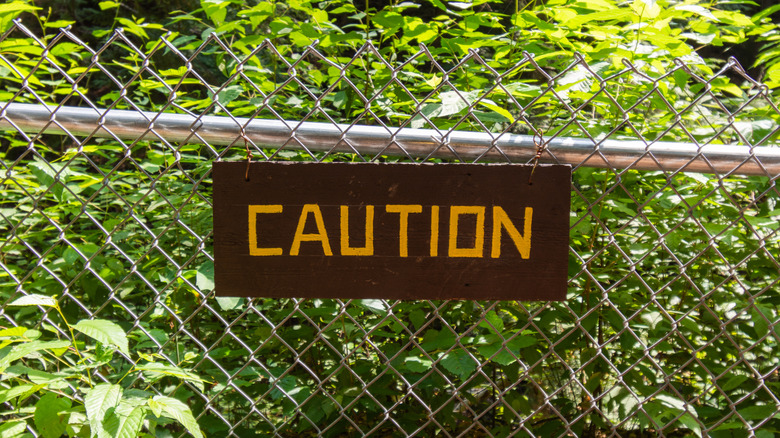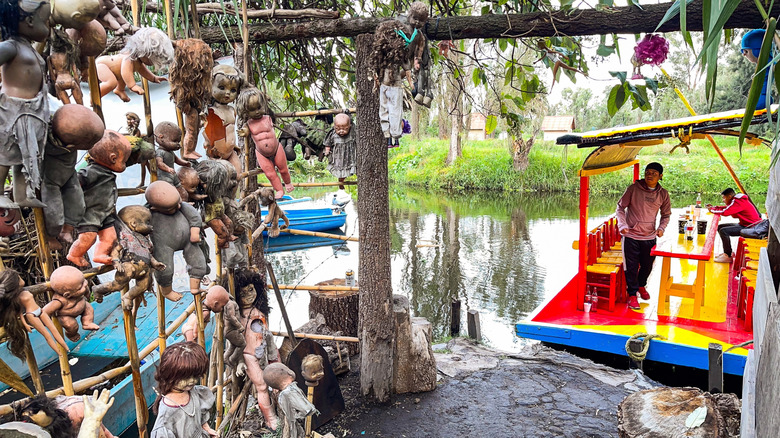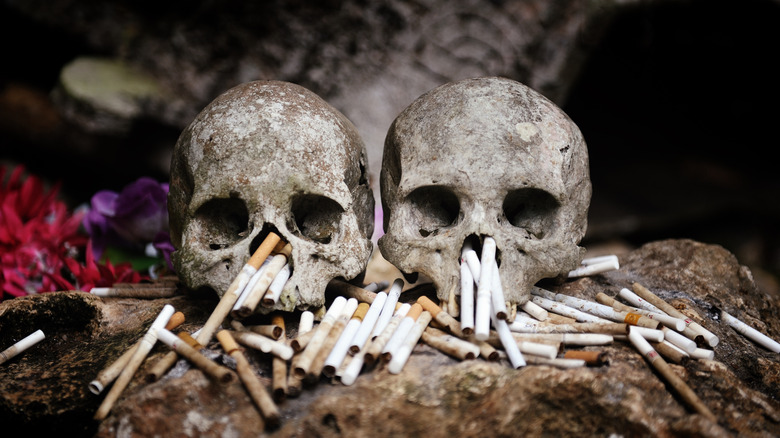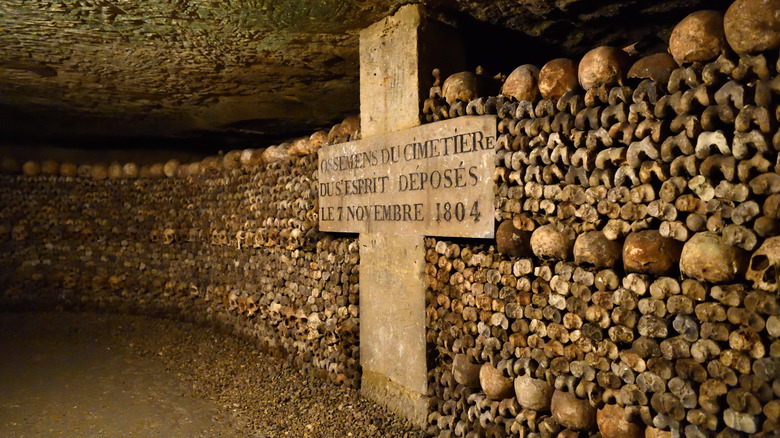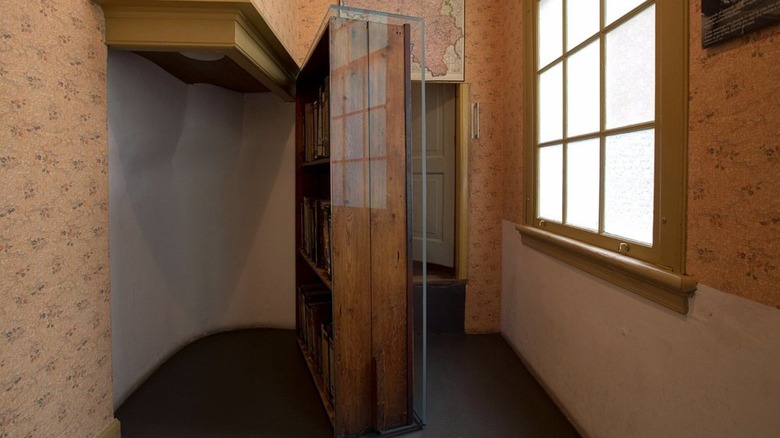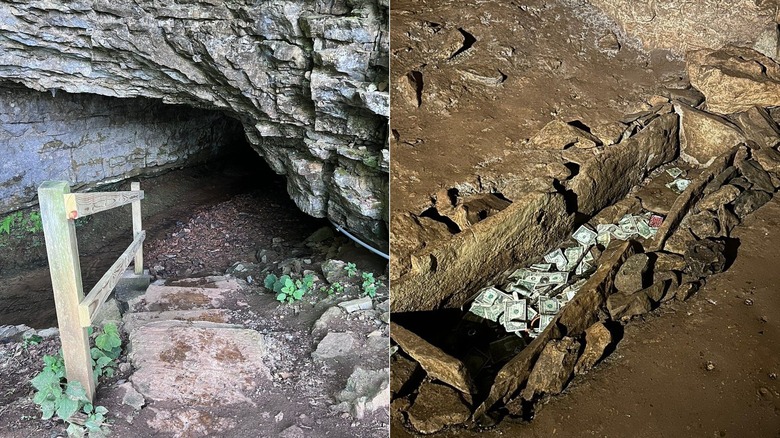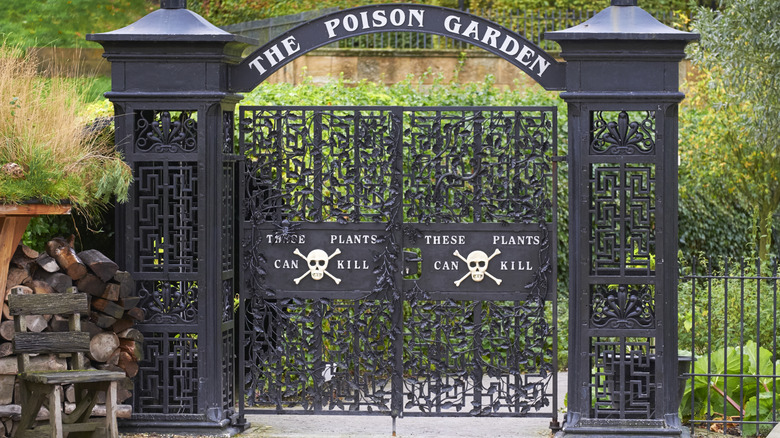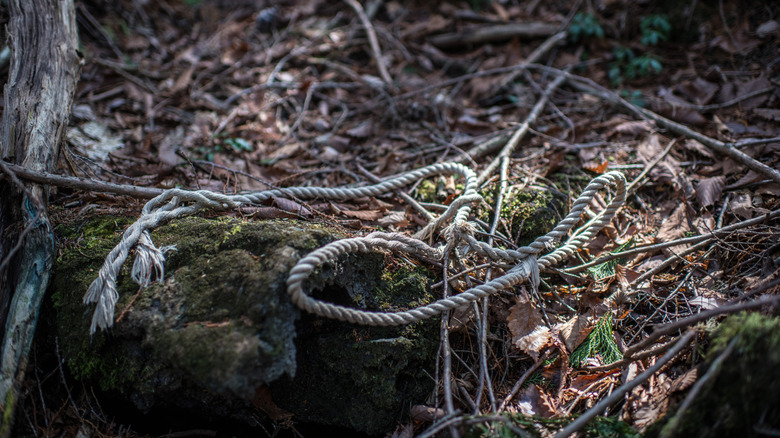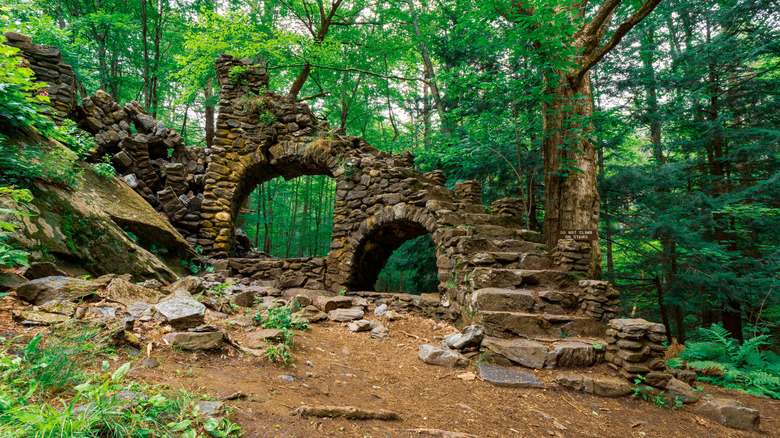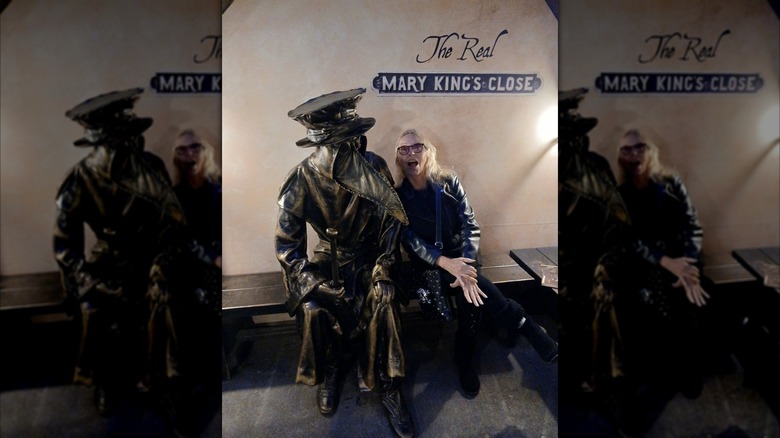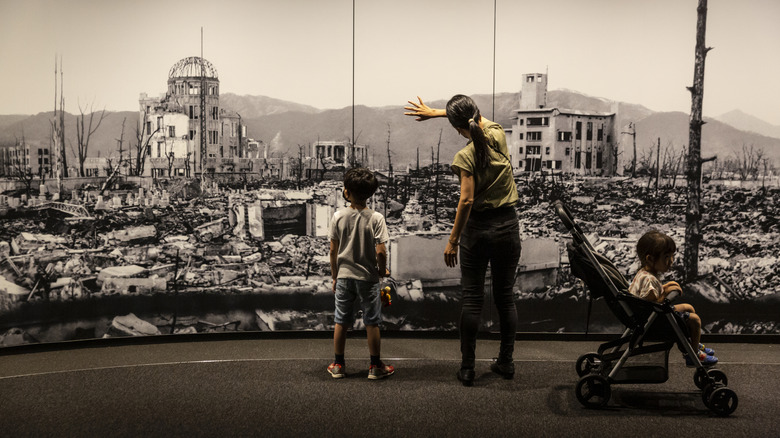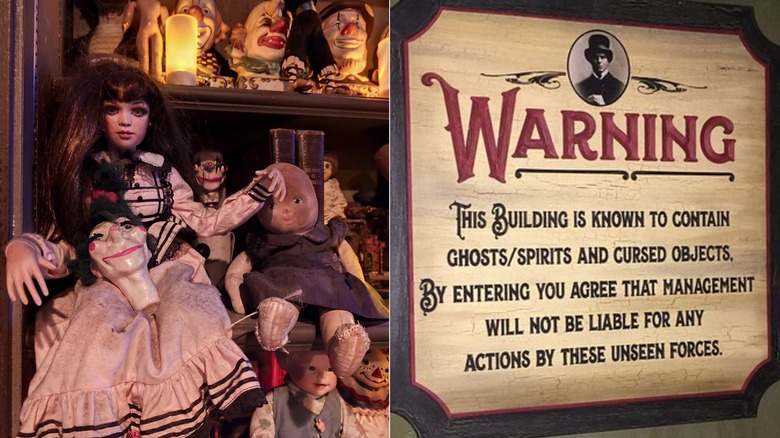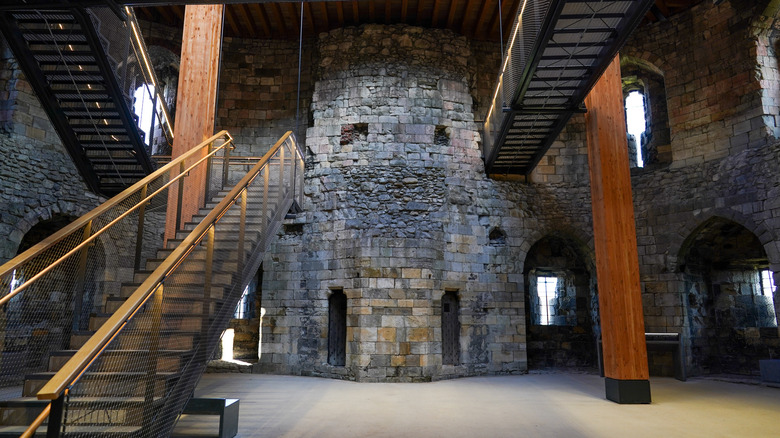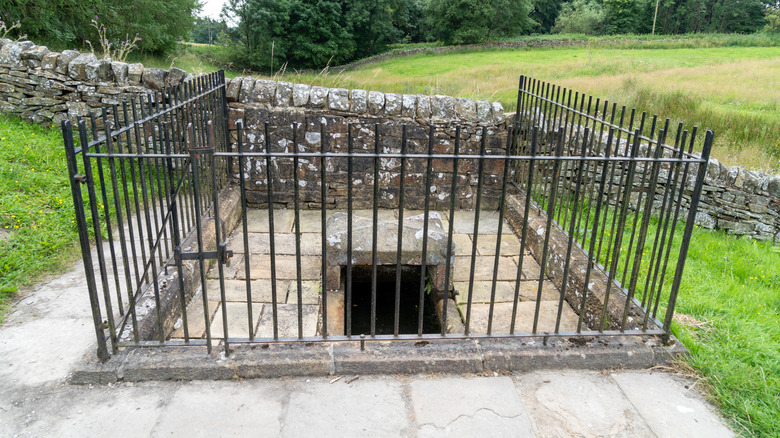13 Harrowing Places Tourists Love To Visit
Different travelers have different tastes. Some like to backpack around the world on a shoestring budget, while others like to vacation in luxury at a top-rated resort. Others do something altogether more unique, visiting the eeriest places in the world, famous for hauntings, bloody history, and devastating tragedies. Dark tourism has come into its own in the last few years, with more people than ever heading off the beaten track to experience the macabre and strange for themselves. These places often welcome the cash injection tourists bring thanks to the popularity of TV shows like the Netflix docuseries, "Dark Tourist."
There are entire islands of dark tourism that are sure to send chills down your spine and unnerve even the most stoic traveler. Other places are tucked away within seemingly normal areas, proving that not everything is as it seems at first glance. Visiting these locations is eye-opening, but be careful — you never know what you might unwittingly bring back with you.
The Island of Dolls, Mexico
Isla de las Munecas, translated as The Island of the Dolls, is situated on a small landmass nestled in the canals of Xochimico in Mexico City — and it has a harrowing history. So the story goes, a man called Don Julian Santana Barrera found a deceased girl floating in the water near the island many years ago. His attempts to save her were unsuccessful, but he later found a way to honor her. He discovered a toy doll floating in the water of the canals and hung it on the tree to commemorate the ill-fated child's life. The sentiment soon grew, and Barrera, reportedly haunted by the spirit of the girl he couldn't save, continued adding more dolls to trees and other structures on the island.
Now, visitors to the spot can see dolls, doll heads, and doll limbs in their hundreds. Barrera's death in 2001 brought even more tourists to the island, all bringing with them their own dolls to add to the shrine. The location can be somewhat tricky to get to, and a boat ride can take around four hours in total.
Toraja, South Sulawesi, Indonesia
A visit to Toraja in South Sulawesi, Indonesia, isn't for the faint of heart. It's an incredibly unique and arguably beautiful place to visit, but locals have some traditions that may halt Westerners in their tracks. Torajans don't have the same attitude towards death as other cultures do. Instead of seeing it as a painful parting and mourning their loved ones, they see it as just another part of life — and a great cause for celebration. As a result, you won't see funerals with masses of crying people wearing black but a five-day-long carnival.
The dead can't be buried until the funeral is all paid for. If the family doesn't have enough money to do this at the time, then the bodies are preserved in formaldehyde and looked after at home, which is a stomach-churning concept to some — but it doesn't stop there. There is a tradition called Ma'Nene, where families of deceased loved ones exhume the bodies after burial, bathe them, and change their clothes every few years. They even make meals for them, and they are placed in the family home to receive visitors. To the Torajans, the dead aren't dead, they're beginning their new lives and need to be cared for as they transition.
The Paris Catacombs, Paris, France
Undoubtedly, the Paris Catacombs are a rare tourist attraction worth waiting in line for. The underground maze of tunnels lined with bones has been attracting visitors in droves for decades and was popular long before the phrase dark tourism was even coined. The location is the final resting place of over six million people, with a history that stretches back to the 18th century. When the project started in 1785, workers were tasked with the macabre job of exhuming remains from the Saints-Innocents cemetery in Paris under the cover of darkness so it wouldn't cause upset among the public. The underground site, which spans over 2,000 acres, began to take shape in the years that followed. In 1809, the doors were open for visitors.
Perhaps unsurprisingly, it's widely believed to be one of the city's most haunted locations. Among other things, reports from visitors have included seeing shadowy apparitions and the intense feeling of being watched. However, the catacombs also have some living dangers. Former Paris resident TikToker Amanda Rollins said, "There are people that live in there full time, there is a community of people that live in the catacombs. [My ex-boyfriend] said to me there are people that live down there and what they will do is when they see you coming in with your map and your flashlights they'll run up to you, grab your flashlight, and grab your map and then run away."
The Anne Frank House, Amsterdam
Sure, Amsterdam isn't the only charming canal city in the Netherlands, but it's home to one of the country's best historical sites. During World War II, the Jewish Frank family was forced to go into hiding to escape persecution. They hid in a secret annex built by Otto Frank, the family patriarch, in a space concealed by a bookcase in the building of his former business. His colleagues helped to keep the family hidden, but they were eventually discovered by Hitler's soldiers. The Franks were sent to Auschwitz, and Otto's wife, and his two daughters, Anne and Margo, died there. Anne's diary of the family's time in hiding was rescued and later published at Otto's wishes, making Anne one of the best-known diarists in world history.
Anne's account of the family's time during the war is emotional and honest, and to this day, the house at Prinsengracht 263 remains a must-see for tourists. Everything has been well-preserved, including the original bookcase that disguised the secret door leading to the attic where the Frank family lived. In 2022 alone, 887,121 visitors visited the site to relive Anne's story.
The Bell Witch cave and cabin, Tennessee, USA
Tennessee is a mecca for tourists who love to take their trips underground. The southern state offers 10,000 caves and caverns to explore, and one of them is the famous Bell Witch cave in Adams. The legend of the Bell Witch is one of America's oldest ghost stories, dating back to 1804 when John Bell and his family moved onto a vast stretch of farmland on the site. Almost 15 years later, strange events unfolded when a disembodied voice began taunting the Bell family with threats. John's youngest daughter, Betsy, was particularly targeted by the entity, which physically harmed her. It soon became known as the "Bell Witch" and allegedly even predicted and took credit for the untimely death of John.
It was speculated at the time that the Bell Witch was the specter of one of John's former jilted girlfriends, Kate Batts. Her spirit is said to haunt a cave on the land close to where the Bell's cabin was. In 1987, a local resident by the name of W. M. Eden told a reporter for The Tennessean, "The cave was Kate's playhouse when she was growing up, and it's the only place she can call home now. I wouldn't go down into the cave alone. People have heard too many things down there — voices, singing, groans, growls, things moving around. Something's there. That's her place." Today, both the cave and a replica of the cabin are open to tourists.
The Poison Garden, Alnwick, England
It's no secret that England is home to many incredible, old, and ancient structures with bloody history, but some of its newer attractions can be just as unsettling. In 2005, Jane, the Duchess of Northumberland, created a unique garden on her family's estate at Alnwick Castle. Instead of the usual rose bushes and marigolds, the duchess made a poison garden, made up of over 100 toxic plants that can kill humans. It's even home to one of the most nefarious plants in the world, known as gympie-gympie. Because of the plant's ability to create a burning sensation that can last years, it's kept safe in a glass case.
Other plants are readily available to touch, although any touching and sniffing of the plants is strictly forbidden. The garden, which hosts guided tours, includes species like laburnum, monkshood, and opium poppy. At the time of writing in February 2025, tickets cost just £13.20 (around $16) per adult to visit. Perhaps surprisingly, kids are also allowed.
The suicide forest, Mount Fuji, Japan
Mount Fuji is one of the most stunning buget destinations in the world, but step off the beaten path and you may find more than you bargained for. Aokigahara forest is situated on the northwest side of Mount Fuji and has earned the unsettling nickname of "suicide forest." The seemingly peaceful and serene wooded area may look like a relaxing place to take a stroll, but it's a notoriously well-known spot for people who wish to end their lives. There is even a volunteer service to reach out to people entering the 12-mile area and persuade them to change their intentions. One such helper, Makoto Kageyama, told BBC Newsbeat in 2018, "You are like a volunteer to actually either find dead bodies or someone who is suicidal."
The forest itself is littered with official signs with information to prevent suicides, and ropes and other personal items are often found scattered along the forest floor. One sign reads, per CNN, "Quietly think once more about your parents, siblings, or children. Please don't suffer alone, and first reach out." Aokigahara became headline news in 2018 when YouTuber Logan Paul filmed a video at the spot that showed him finding a body.
If you or someone you know is struggling or in crisis, help is available. Call or text 988 or chat 988lifeline.org.
Madame Sherri Forest, New Hampshire, USA
New Hampshire is full of scenic spots to visit, but more adventurous travelers make a beeline for the romantically named Madame Sherri Forest in Chesterfield. The woodland itself is beautiful and serene, but it's the castle ruins that make this place alluring and unique. As legend has it, a costume designer from New York named Madame Antoinette Sherri built a lavish mansion shaped like a castle where she would entertain guests from all over. Things went swimmingly for the lady of means until her fortune dwindled, and the castle slipped into extreme disrepair.
Eventually, the home was burned down when a fire broke out. Today, it's nothing but ruins, but strange goings-on have been reported by visitors to the site. Some say that if you're lucky, you may see Madame Sherri at the top of the staircase, or hear music and laughter radiating from the deserted ruins. Either way, this is an eerie reminder that all good things come to an end, even if they're built to last.
Mary King's Close, Edinburgh, Scotland
To visit Mary King's Close in Edinburgh is to feel as though you stepped back in time. This underground close (or alleyway) is buried underneath the city's lively Royal Mile, but how did an entire neighborhood become a subterranean tourist attraction? Before 1753, Mary King's Close had been a busy street like many others, but because of overcrowding the plague and other diseases made it an unhealthy, bacteria-ridden locality. Rather than demolish the entire area, the decision was made to build the Royal Exchange over it, so that goods could be traded without the overwhelming risks that the pestilence presented. Even after the close was covered over, some tenants remained, living in the darkness.
The area remains much as it was (although arguably cleaner) back then and is open as an attraction. Enormous buildings, some reaching eight stories high, still greet visitors who are brave enough to enter. As you may expect, tales of hauntings are rife. One psychic claimed that a little girl called Annie inhabited one of the areas and desperately wanted a doll to play with. Since then, visitors have placed dolls and teddy bears on the spot for the ghost, believed to be a plague victim, to enjoy.
Hiroshima Peace Memorial Museum, Hiroshma, Japan
The devastation caused by an atomic bomb is a different level of catastrophe. In 1945, America deployed the first atomic bomb when it targeted Hiroshima in Japan. The results were unlike anything humanity had ever experienced, taking 80,000 lives upon impact and thousands more in the time that followed. The decision to deploy the bomb, made by President Truman, is still hotly debated today. Tourists who want to better understand the events leading up to, during, and after the attack, can visit the Hiroshima Peace Memorial Museum in Hiroshima.
The museum has displays that include the belongings of the victims, as well as photographs of the grand scale of the destruction. It aims to make it clear just how dangerous atomic bombs are and to push the hopeful message that it should never happen again, no matter the circumstances.
Zak Bagans' Haunted Museum, Las Vegas, America
The most haunted destinations in the entire world are usually old properties or creepy areas that have a storied history. However, "Ghost Adventures" star Zak Bagans engineered his own otherworldly phenomenon by amassing a large collection of haunted and cursed objects. Zak Bagans' Haunted Museum is situated in downtown Las Vegas, and the building was reportedly known to be haunted by aggressive and angry ghosts before Bagans purchased it. The sprawling property is now home to many different items, from a possessed wine cupboard to an object known as the Dybbuk Box.
The energy within the museum is reportedly so intense that visitors have to sign a waiver before entering. Some people are skeptical about whether the museum is really as haunted as Bagans would have you believe, but for fans of the paranormal, it's a one-stop-shop for all things macabre. Other items on display include the camper van of Dr. Jack Kevorklan, a doll called Peggy thought to cause nosebleeds, and a piece of the car James Dean was driving when he died.
Clifford's Tower, York, England
Brits know all too well why York is Europe's most haunted destination, but if you haven't visited the historic city, then you may be clueless. The city dates back to Roman times when it was founded in 71 C.E. Over the years it saw Viking conquests and many bloody battles, but one of its most harrowing events unfolded within the walls of Clifford's Tower. Back in 1190, tensions between York's Jewish population and Christian locals were on the rise. Jews sought protection inside the walls of the tower, situated close to the center of York. However, the Jews and the keeper of the tower didn't see eye to eye, and when he left one day, they wouldn't let him back in.
A mob, angry that the Jews had seemingly disrespected the King of England, surrounded the tower. With nowhere to turn, the men inside killed their families before killing themselves. The massacre is one of the earliest grand-scale acts of anti-Semitism in England's history. Today, the tower is owned by English Heritage, and it's open to the public. The tower is home to many reported hauntings, including walls that appear to bleed.
Eyam Village, Derbyshire, England
Some villages are famous for their picturesque buildings and scenic fields, while others become known for different, darker reasons. Eyam Village in Derbyshire fell victim to the plague in 1665, much like other areas in England. The plague was quick to spread, but villagers made the ultimate sacrifice. The entire village sealed itself off from the outside world, to limit the spread and a large percentage of the population died as a result of their selfless act.
Supplies were brought to the boundary of the village and left beside a well, known as Mompesson's Well. Villagers would leave coins inside the well, which was filled with vinegar, to pay for the goods. The vinegar was thought to adequately disinfect the coins so the tradesman wouldn't catch the infection. Today, Eyam attracts visitors from at home as well as abroad and keenly shares its sad past. Outside many of the houses, there are lists naming the victims who died during the trying period.
